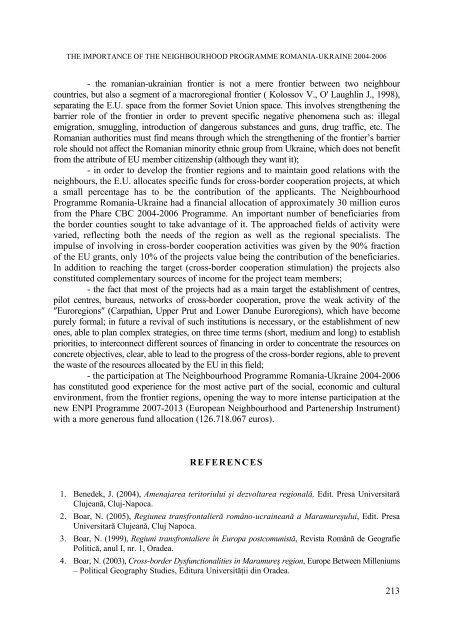geographia - Studia
geographia - Studia
geographia - Studia
Create successful ePaper yourself
Turn your PDF publications into a flip-book with our unique Google optimized e-Paper software.
THE IMPORTANCE OF THE NEIGHBOURHOOD PROGRAMME ROMANIA-UKRAINE 2004-2006<br />
- the romanian-ukrainian frontier is not a mere frontier between two neighbour<br />
countries, but also a segment of a macroregional frontier ( Kolossov V., O' Laughlin J., 1998),<br />
separating the E.U. space from the former Soviet Union space. This involves strengthening the<br />
barrier role of the frontier in order to prevent specific negative phenomena such as: illegal<br />
emigration, smuggling, introduction of dangerous substances and guns, drug traffic, etc. The<br />
Romanian authorities must find means through which the strengthening of the frontier’s barrier<br />
role should not affect the Romanian minority ethnic group from Ukraine, which does not benefit<br />
from the attribute of EU member citizenship (although they want it);<br />
- in order to develop the frontier regions and to maintain good relations with the<br />
neighbours, the E.U. allocates specific funds for cross-border cooperation projects, at which<br />
a small percentage has to be the contribution of the applicants. The Neighbourhood<br />
Programme Romania-Ukraine had a financial allocation of approximately 30 million euros<br />
from the Phare CBC 2004-2006 Programme. An important number of beneficiaries from<br />
the border counties sought to take advantage of it. The approached fields of activity were<br />
varied, reflecting both the needs of the region as well as the regional specialists. The<br />
impulse of involving in cross-border cooperation activities was given by the 90% fraction<br />
of the EU grants, only 10% of the projects value being the contribution of the beneficiaries.<br />
In addition to reaching the target (cross-border cooperation stimulation) the projects also<br />
constituted complementary sources of income for the project team members;<br />
- the fact that most of the projects had as a main target the establishment of centres,<br />
pilot centres, bureaus, networks of cross-border cooperation, prove the weak activity of the<br />
″Euroregions″ (Carpathian, Upper Prut and Lower Danube Euroregions), which have become<br />
purely formal; in future a revival of such institutions is necessary, or the establishment of new<br />
ones, able to plan complex strategies, on three time terms (short, medium and long) to establish<br />
priorities, to interconnect different sources of financing in order to concentrate the resources on<br />
concrete objectives, clear, able to lead to the progress of the cross-border regions, able to prevent<br />
the waste of the resources allocated by the EU in this field;<br />
- the participation at The Neighbourhood Programme Romania-Ukraine 2004-2006<br />
has constituted good experience for the most active part of the social, economic and cultural<br />
environment, from the frontier regions, opening the way to more intense participation at the<br />
new ENPI Programme 2007-2013 (European Neighbourhood and Partenership Instrument)<br />
with a more generous fund allocation (126.718.067 euros).<br />
REFERENCES<br />
1. Benedek, J. (2004), Amenajarea teritoriului şi dezvoltarea regională, Edit. Presa Universitară<br />
Clujeană, Cluj-Napoca.<br />
2. Boar, N. (2005), Regiunea transfrontalieră româno-ucraineană a Maramureşului, Edit. Presa<br />
Universitară Clujeană, Cluj Napoca.<br />
3. Boar, N. (1999), Regiuni transfrontaliere în Europa postcomunistă, Revista Română de Geografie<br />
Politică, anul I, nr. 1, Oradea.<br />
4. Boar, N. (2003), Cross-border Dysfunctionalities in Maramureş region, Europe Between Milleniums<br />
– Political Geography Studies, Editura Universităţii din Oradea.<br />
213
















